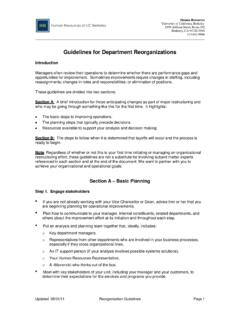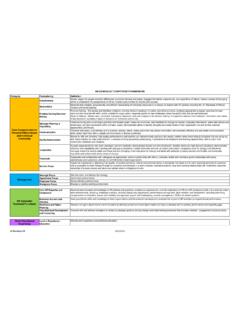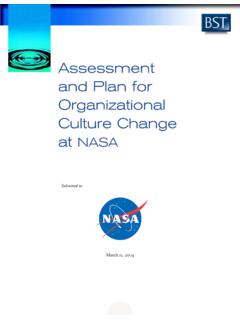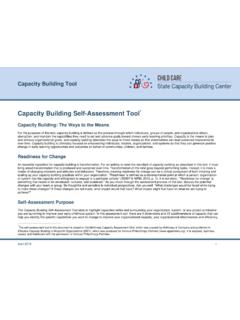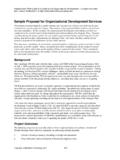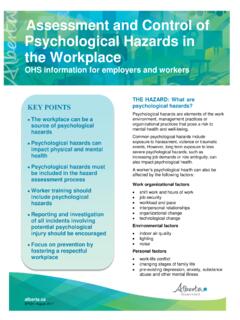Transcription of Change Management Toolkit - People & Culture
1 Change Management Toolkit 0 | Page Change Management Toolkit Tips, tools, and techniques for leading a successful Change initiative VCA Business Process Management Office (BPMO), Priya Sarran Central HR organizational Effectiveness, Delia Clark Central HR Learning & Development, Kathy Mendonca Change Management Toolkit 1 | Page Table of Contents How to Use this Toolkit .. 2 Why Change Management ? .. 3 What happens if a Necessary Change Management Component is missing? .. 4 Change Management Pre-work .. 5 To Change Behavior Direct the Rider.
2 6 Case for Change Template .. 7 Compelling Vision Interview Template .. 8 Working with Your Sponsor Overview .. 9 Sponsor Expectation Tool .. 10 Stakeholder Analysis and Engagement plan Overview .. 11 Stakeholder Analysis and Engagement plan Template .. 15 Change Readiness assessment (baseline).. 16 Behavioral Change plan .. 17 Team Communication Overview .. 19 Team Communication plan .. 20 Manage Personal Transitions (resistance) .. 21 To Change Behavior Motivate the Elephant .. 22 Transition Model (Bridges).. 23 Change Process Model (Kubler-Ross).
3 24 Change Process Model Indicators & Strategies (Kubler-Ross) .. 25 Core Values Exercise .. 27 Best Practices for Leading Change What to Do .. 28 Best Practices for Leading Change What NOT to Do .. 29 Develop Change plan .. 30 To Change Behavior Shape the Path .. 31 Implementation Strategies .. 32 Risk assessment Template .. 33 Success Metrics Overview .. 35 Success Metrics Template .. 36 Feedback Strategy Overview .. 37 Feedback Strategy Options .. 38 Change Communications plan Overview .. 40 Change Communications plan Template.
4 41 Change Communication Brief Template .. 45 Implement & Monitor the 46 To Sustain the Change Keep the Momentum Going .. 47 Change Readiness assessment (final check before pilot/big bang) .. 48 Monitor Metrics for Continuous Improvement .. 49 Change Management Toolkit 2 | Page How to Use this Toolkit Why is a Change Management Toolkit necessary? In the 21st century we are surrounded by constant innovation, technology enhancements, and a connection to a global network, all of which has created a new normal of perpetual Change .
5 As a way of handling the increased volume of Change , a plethora of proven tools and techniques have been created to aid individuals in managing Change . As a result of these tools and techniques being globally socialized and tested, the necessary components for effectively managing Change are known. These proven tools and techniques have been reviewed and curated into this Toolkit which contains those most appropriate for use at UC Berkeley. Who is this Toolkit for? This Toolkit is designed for any individual responsible for leading a Change initiative of any size.
6 How to use this Toolkit ? This Toolkit begins with an introduction to the importance of Change Management and goes over the seven components necessary to effectively manage Change . It is organized into four main sections: (1) Change Management Pre-work (2) Manage Personal Transitions (resistance) (3) Develop Change plan (4) Implement & Monitor the Change . Each of these sections contain a collection of tools and techniques which organize the work needed for the Change initiative and they are best followed chronologically.
7 While a multitude of tools are provided, not all tools will be necessary for every Change . When considering which tools to use, review the scope of the Change identified in the Project Charter. For large scale initiatives, it is recommended that all tools be used in each section of the Toolkit . For small to medium sized initiatives, at a bare minimum, the following tools should be used: Case for Change template (page 7) Compelling vision Interview template (page 8) Change communication plan overview & template (pages 40-41) Change Readiness assessment (page 16) Manage Personal Transitions (resistance) Section (pages 21-29) Feedback Strategy Overview & Options (pages 37-38) Behavioral Change plan (page 17) Change Management Toolkit 3 | Page Why Change Management ?
8 As a top-ranked public research university, UC Berkeley serves as a flagship institution when it comes to our bold and innovative initiatives. Change Management is often the key component in driving the success of these ventures. As we know from our own experience, not all Change initiatives are equally disruptive. Some will have a greater impact and be more challenging. Others may be barely noticeable. Change can be bucketed into two main categories: Incremental and Transformational. Incremental Change is easier to implement successfully.
9 It is often based on the current state in order to improve the existing way of doing our work. It typically involves fewer changes and affects a small number of People . On the other hand, Transformational Change is more difficult to implement, typically having only a 30% success rate. (Taking Stock survey by The Change Management Toolbook, February 2005) Why is that? Things get more challenging when the Change is Transformational because it is designed from a future state and involves a fundamentally new way of doing things.
10 This typically involves significant Culture Change and affects a large number. The complexity involved in Culture Change is often why it is easier to Change the Change than it is to Change the Culture . Culture is our values, beliefs, assumptions, and unwritten rules. These shape our behaviors and mindset as well as our performance. Individuals within an organization co-create the Culture through conversations and by following behavioral norms. In addition to the overarching Culture of an organization, individual subcultures often exist.
